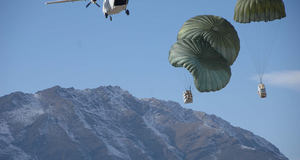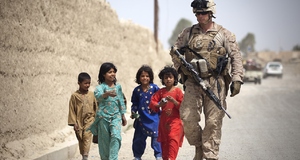Private Security Contractors in Afghanistan as Third-Party Propagators: Categorizing the Participation of Private Security Companies
By
2012, Vol. 4 No. 08 | pg. 3/3 | « This scenario suggests the nature of private security contractors as third-party propagators, and poses several important questions regarding the regulation of these companies. Since “[t]heir very existence relies on conflict,” mechanisms must be implemented in order to place these firms within existing legal structures in order to hold them to the same standards of accountability as state-sanctioned soldiers.66 Especially important to such legal controls is determining a mechanism by which any abuses can be fairly investigated, prosecuted, and punished.67 Congress should also take a more direct role in regulating PSCs by establishing firm “contracting and hiring practices that includes what activities are permitted and restricted.”68 Without such oversight, restricting the behavior of these third-party instigators will be largely impossible given the transferability of contracts and the tangled web of subcontracts that complicate a determination of who is truly responsible for propagating a conflict. ConclusionConventional third-party intermediation has come to be defined by three broad categories: state interventions, the involvement of international organization, and the role of transnational actors. Within Afghanistan, the involvement of states in easing tensions between the Taliban-led, Afghan government failed to reach an agreement that would prevent conflict from breaking out in the region. Likewise, the United States’ decision to invade Afghanistan without the authorization of the United Nations Security Council rendered the mediatory role of international organizations irrelevant in this conflict, but they have since been instrumental in coordinating reconstruction efforts in the country. Finally, transnational actors—typified by insurgents who wage war in Afghanistan but retreat to Pakistan for the purposes of regrouping—have complicated the counterinsurgency effort in the region.Interestingly, private security firms have previously been categorized within this same final grouping as transnational actors. Nevertheless, this paper has argued that this label merely represents an initial classification. Using Afghanistan as a case study for how these firms operate, PSCs are more appropriately labeled as third-party propagators, instigating conflict in order to create an artificial demand for their services. Billions of dollars later, private security firms maintain an active presence in Afghanistan, but not without reports of colluding with Taliban insurgents in order to achieve their contractual obligations. Indeed, as a NATO official in Kabul reportedly stated: “We’re funding both sides of the war.”69 In order for these third-party contractors to lose their status as instigators of conflict requires a greater level of oversight of these firms. Such regulation might include, but is certainly not limited to, determining adequate legal structures under which to restrict these companies, establishing a mechanism for trying abuses in a fair manner, and limiting contracting and hiring practices while also establishing a code of conduct by which contractors are to operate. Without such regulation, all conflicts in which there is substantial participation by private security companies risk becoming intractable. References“Blackwater Worldwide.” 2011. New York Times. April 25. . Abbott, Kenneth W., and Duncan Snidal. (1998). Why States Act through Formal International Organizations. Journal of Conflict Resolution: Sage Publications. 42(1). February. pp. 3-32. Azzi, Pierre. (1999). Recognizing the Taliban. Harvard International Review. 21(2). < http://hir.harvard.edu/harsh-rule>. Spring. BBC News. (2011). “Afghan president orders private security closures.” BBC News (UK). August 17. . Center for International Development and Conflict Management. \"ICB Data Viewer.\"CIDCM. Department of Political Science: McGill University. . Colás, Alejandro. (2002). International Civil Society: Social Movements in World Politics. Blackwell Publishers: Cambridge (UK). Crenshaw, Martha. (2001). Why America? The Globalization of Civil War. Salem State University Press: Boston. . 6. DeVecchi, Robert P. (2002). The Role of Non-Governmental Organizations in Afghanistan’s Recovery. Council on Foreign Relations. January 18. < http://www.cfr.org/afghanistan/role-non-governmental-organizations-afghanistans-recovery/p4511>. Evans, Graham and Richard Newnham. (1998). Penguin Dictionary of International Relations. Penguin: New York. p. 270 Filkins, Dexter. (2010). Rule of the Gun Convoy Guards in Afghanistan Face an Inquiry. June 7. Fisher, Ronald J. (1997). Interactive Conflict Resolution. Syracuse University Press: Syracuse University Press. 142. French, Howard W. (2002). More than $4.5 billion pledged in Afghan aid effort. New York Times: New York. January 22. . Gómez del Prado, José Luis. (2008). “Check against delivery.” Oral Statement to the United Nations Human Rights Council: Geneva. March 10. GAO. (2003). Military Operations: Contractors Provide Vital Services to Deployed Forces but Are Not Adequately Addressed in DOD Plans. GAO-03-695. June. 8. Isenberg, David. (2010). Private Military Contractors as Buzz Lightyear: To Afghanistan and Beyond. The Cato Institute. March 11. . Jalali, Ali A. (2007). “Afghanistan: Regaining Momentum.” Parameters. Winter 2007. 5-19. Jones, Oliver. (2008). Implausible Deniability: State Responsibility for the Acts of Private Security Firms. In The Selected Works of Oliver Jones. < http://works.bepress.com/oliver_jones/2>. Kidwell, Deborah C. (2005). Public War, Private Fight? The United States and Private Military Companies. Global War on Terrorism Occasional Paper 12. Combat Studies Institute Press: Fort Leavenworth, Kansas. 9. Lendman, Stephan. (2010). Outsourcing War: The Rise of Private Military Contractors (PMCs). January 19. . Lovelace, Douglas C. Jr. (2010). Transnational Insurgencies and the Escalation of Regional Conflict: Lessons for Iraq and Afghanistan. Strategic Studies Institute: United States Army. March. ix. McCoy, Katherine. (2009). Uncle Sam Wants Them. Contexts: American Sociological Association. Winter. 14-19. Miller, Zachary. (2010). Rethinking Third-Party Interventions into Insurgencies: The Logic of Commitment. School of Advanced Military Studies: United States Army Command and General Staff College. Morris, Erika. (2009). Private Warfare: History of the Increasing Dependency on Private Military Corporations and Implications. . Mulrine, Anna. (2009). Obama to Confront Limits of America’s Overstretched Military. US News & World Report. < http://www.usnews.com/articles/news/world/2009/01/16/obama-to-confront-limits-of-americas-overstretched-military.html>. January 16. Olson, Mancur. (1971). The Logic of Collective Action: Public Goods and the Theory of Groups. Harvard University Press. 2nd Edition. 14. Princen, Thomas. (1992). Intermediaries in International Conflict. Princeton, NJ: Princeton University Press. 15. Princen, Thomas. (1992). Mediation by a Transnational Organization: the Case of the Vatican. In Mediation in International Relations. In Jacob Bercovitch and Jeffrey Z. Rubin. St. Martin’s Press: London. 149. Regan, Patrick M. (1996). Conditions of Successful Third-Party Intervention in Intrastate Conflicts. Sage Publications: The Journal of Conflict Resolution. 40(2). 339. Schulman, Daniel. (2010). Are contractors undermining US war efforts? Mother Jones Magazine. January 21. Schwartz, Moshe. (2011). The Department of Defense’s Use of Private Security Contractors in Afghanistan and Iraq: Background, Analysis, and Options for Congress. Congressional Research Service. . February 21. i. Singer, Peter. (2007). The Dark Truth about Blackwater. Brookings Institution: 21st Century Defense Initiative. . October 2. Slim, Randa M. (1992). Small-State Mediation in International Relations: The Algerian Mediation of the Iranian Hostage Crisis. In Mediation in International Relations. In Jacob Bercovitch and Jeffrey Z. Rubin. St. Martin’s Press: London. 226. Smith, Jeffrey and Joby Warrick. (2009). Blackwater tied to clandestine CIA raids. The Washington Post. . December 11. The Guardian. (2001). Saudi Arabia severs ties with Taliban. . September 25. United States Department of Defense. (2011). Contractor support of U.S. operations in the USCENTCOM Area of Responsibility, Iraq and Afghanistan. < www.acq.osd.mil.log/PS/docs/5A_paper/5A_April2011.doc>. April. Wagemaker, Allard. (2008). Rescuing Afghanistan? Small Western Liberal Democracies and Multinational Intervention. Austrian Armed Forces. . 46. Zartman, I. William and Saadia Touval. (1996). "International Mediation in the Post-Cold War Era," in Managing Global Chaos, eds. Chester Crocker, Fen Hampson and Pamela Aall, (Washington, D.C.: United States Institute of Peace Press, 1996) p. 445-461. Endnotes 1.) Mancur Olson, 1971. The Logic of Collective Action: Public Goods and the Theory of Groups. Harvard University Press. 2nd Edition. 14. 2.) Katherine McCoy, 2009. Uncle Sam Wants Them. Contexts: American Sociological Association. Winter. 14-19. 3.) Anna Mulrine, 2009. Obama to Confront Limits of America’s Overstretched Military. US News & World Report. < http://www.usnews.com/articles/news/world/2009/01/16/obama-to-confront-limits-of-americas-overstretched-military.html>. January 16. 4.) This paper will refer to “private security companies (PSCs)” as “private military contractors (PMCs),” “private military firms (PMFs),” “mercenaries,” and “private security contractors.” All names are used synonymously. 5.) McCoy, 15. 6.) Moshe Schwartz, 2011. The Department of Defense’s Use of Private Security Contractors in Afghanistan and Iraq: Background, Analysis, and Options for Congress. Congressional Research Service. <http://www.fas.org/sgp/crs/natsec/R40835.pdf >. February 21. i. 7.) R. Jeffrey Smith and Joby Warrick, 2009. Blackwater tied to clandestine CIA raids. The Washington Post. <http://www.washingtonpost.com/wp-dyn/content/article/2009/12/10/AR2009121004700.html?nav=emailpage>. December 11. 8.) Schwartz, I. 9.) United States Department of Defense, 2011. Contractor support of U.S. operations in the USCENTCOM Area of Responsibility, Iraq and Afghanistan. < www.acq.osd.mil.log/PS/docs/5A_paper/5A_April2011.doc>. April. 10.) Thomas Princen, 1992. Intermediaries in International Conflict. Princeton, NJ: Princeton University Press. 15. 11.) For a more thorough discussion, refer to recent articles on third-party interventions written by Kyle Beardsley, Andrew Kydd, Barbara Walter, and/or Page Fortna. 12.) Princen, 6. 13.) Saadia Touval and William Zartman, 2001. International Mediation in the Post-Cold War Era. In Crocker, Hampson, and Aall. 428. 14.) Princen, 14. 15.) Princen, 6. 16.) Zachary Miller. 2010. Rethinking Third-Party Interventions into Insurgencies: The Logic of Commitment. School of Advanced Military Studies: United States Army Command and General Staff College. < http://www.dtic.mil/cgi-bin/GetTRDoc?AD=ADA523117&Location=U2&doc=GetTRDoc.pdf>. 41. 17.) Pierre Azzi. 1999. Recognizing the Taliban. Harvard International Review. 21(2). < http://hir.harvard.edu/harsh-rule>. Spring. 18.) Literally: “pre-war.” For a more thorough discussion of this and related concepts, refer to: James Fearon. 1994. Rationalist Explanations for War. International Organization. 49(3). 379-414. 19.) Martha Crenshaw. 2001. Why America? The Globalization of Civil War. Salem State University Press: Boston. <https://preview.salemstate.edu/~cmauriello/pdf_his102/Why%20America.pdf>. 6. 20.) The Guardian (UK). 2001. Saudi Arabia severs ties with Taliban. <http://www.guardian.co.uk/world/2001/sep/25/afghanistan.terrorism7>. September 25. 21.) Allard Wagemaker. 2008. Rescuing Afghanistan? Small Western Liberal Democracies and Multinational Intervention. Austrian Armed Forces. <http://www.oebh.at/pdf_pool/publikationen/civ_mil_coop_bsp_afgha_004_rescuin_afghanistan_a_wagemaker_42.pdf>. 46. 22.) Ronald J. Fisher. 1997. Interactive Conflict Resolution. Syracuse University Press: Syracuse University Press. 142. 23.) Randa M. Slim. 1992. Small-State Mediation in International Relations: The Algerian Mediation of the Iranian Hostage Crisis. In Mediation in International Relations. In Jacob Bercovitch and Jeffrey Z. Rubin. St. Martin’s Press: London. 226. 24.) Slim, 227. 25.) Princen, 30. 26.) Center for International Development and Conflict Management. 2011. "ICB Data Viewer."CIDCM. Department of Political Science: McGill University. . 27.) Princen, 30. 28.) Peter Singer, 2007. The Dark Truth about Blackwater. Brookings Institution: 21st Century Defense Initiative. . October 2. 29.) Kenneth W. Abbott and Duncan Snidal. 1998. Why States Act through Formal International Organizations. Journal of Conflict Resolution: Sage Publications. 42(1). February. pp. 3-32. 30.) Graham Evans and Richard Newnham.1998. Penguin Dictionary of International Relations. Penguin: New York. p. 270 31.) Abbott and Snidal, 5. 32.) Literally: “after-war.” For a more thorough discussion of this and related concepts, refer to: James Fearon. 1994. Rationalist Explanations for War. International Organization. 49(3). 379-414. 33.) Robert P. DeVecchi. 2002. The Role of Non-Governmental Organizations in Afghanistan’s Recovery. Council on Foreign Relations. January 18. < http://www.cfr.org/afghanistan/role-non-governmental-organizations-afghanistans-recovery/p4511>. 34.) Patrick M. Regan. 1996. Conditions of Successful Third-Party Intervention in Intrastate Conflicts. Sage Publications: The Journal of Conflict Resolution. 40(2). 339. 35.) Howard W. French. 2002. More than $4.5 billion pledged in Afghan aid effort. New York Times: New York. January 22. < http://www.nytimes.com/2002/01/22/international/asia/22AID.html>. 36.) DeVecchi, 2002. 37.) Daniel Schulman. 2010. Are contractors undermining US war efforts? Mother Jones Magazine. January 21. 38.) Thomas Princen. 1992. Mediation by a Transnational Organization: the Case of the Vatican. In Mediation in International Relations. In Jacob Bercovitch and Jeffrey Z. Rubin. St. Martin’s Press: London. 149. 39.) For more information, refer to Princen, 133. 40.) Alejandro Colás. 2002. International Civil Society: Social Movements in World Politics. Blackwell Publishers: Cambridge (UK). 2. 41.) Princen in Bercovitch and Rubin, 150. 42.) Ali A. Jalali. 2007. “Afghanistan: Regaining Momentum.” Parameters. Winter 2007. 5-19. 43.) Douglas C. Lovelace, Jr. 2010. Transnational Insurgencies and the Escalation of Regional Conflict: Lessons for Iraq and Afghanistan. Strategic Studies Institute: United States Army. March. ix. 44.) José Luis Gómez del Prado. 2008. “Check against delivery.” Oral Statement to the United Nations Human Rights Council: Geneva. March 10. 45.) Ibid. 46.) Princen, 133. 47.) Deborah C. Kidwell. 2005. Public War, Private Fight? The United States and Private Military Companies. Global War on Terrorism Occasional Paper 12. Combat Studies Institute Press: Fort Leavenworth, Kansas. 9. 48.) Schwartz, 1. 49.) GAO, 2003. Military Operations: Contractors Provide Vital Services to Deployed Forces but Are Not Adequately Addressed in DOD Plans. GAO-03-695. June. 8. 50.) Adapted from Schwartz, 2. 51.) David Isenberg. 2010. Private Military Contractors as Buzz Lightyear: To Afghanistan and Beyond. The Cato Institute. March 11. . 52.) Schwartz, 21. 53.) Isenberg. 54.) BBC News. 2011. “Afghan president orders private security closures.” BBC News (UK). August 17. <http://www.bbc.co.uk/news/world-south-asia-10999753>. 55.) McCoy, 15. 56.) New York Times, 2011. Blackwater Worldwide. April 25. <http://topics.nytimes.com/top/news/business/companies/blackwater_usa/index.html?scp=1&sq=blackwater%20kills%2017&st=cse>. 57.) Schwartz, 13. 58.) Dexter Filkins. 2010. Rule of the Gun Convoy Guards in Afghanistan Face an Inquiry. June 7. <http://www.nytimes.com/2010/06/07/world/asia/07convoys.html?pagewanted=1&_r=1> 59.) Lendman, 10. 60.) Filkins, 2010. 61.) Ibid. 62.) Stephan Lendman.2010. Outsourcing War: The Rise of Private Military Contractors (PMCs). January 19. <http://www.thepeoplesvoice.org/TPV3/Voices.php/2010/01/19/outsourcing-war-the-rise-of-private-mili>. 63.) Based on data collected by Schwartz, 21. 64.) Schwartz, 15. 65.) Both graphs were constructed with data from Schwartz, 21 and www.icasualties.org. 66.) Oliver Jones. 2008. Implausible Deniability: State Responsibility for the Acts of Private Security Firms. In The Selected Works of Oliver Jones. < http://works.bepress.com/oliver_jones/2>. 67.) Erika Morris. 2009. Private Warfare: History of the Increasing Dependency on Private Military Corporations and Implications. <http://digitalcommons.usu.edu/cgi/viewcontent.cgi?article=1005&context=honors>. 68.) Ibid. 69.) Filkins, 2010 Suggested Reading from Inquiries Journal
Inquiries Journal provides undergraduate and graduate students around the world a platform for the wide dissemination of academic work over a range of core disciplines. Representing the work of students from hundreds of institutions around the globe, Inquiries Journal's large database of academic articles is completely free. Learn more | Blog | Submit Latest in International Affairs |


















